FIAT BARCHETTA 2003 1.G Owners Manual
Manufacturer: FIAT, Model Year: 2003, Model line: BARCHETTA, Model: FIAT BARCHETTA 2003 1.GPages: 170, PDF Size: 3.55 MB
Page 131 of 170
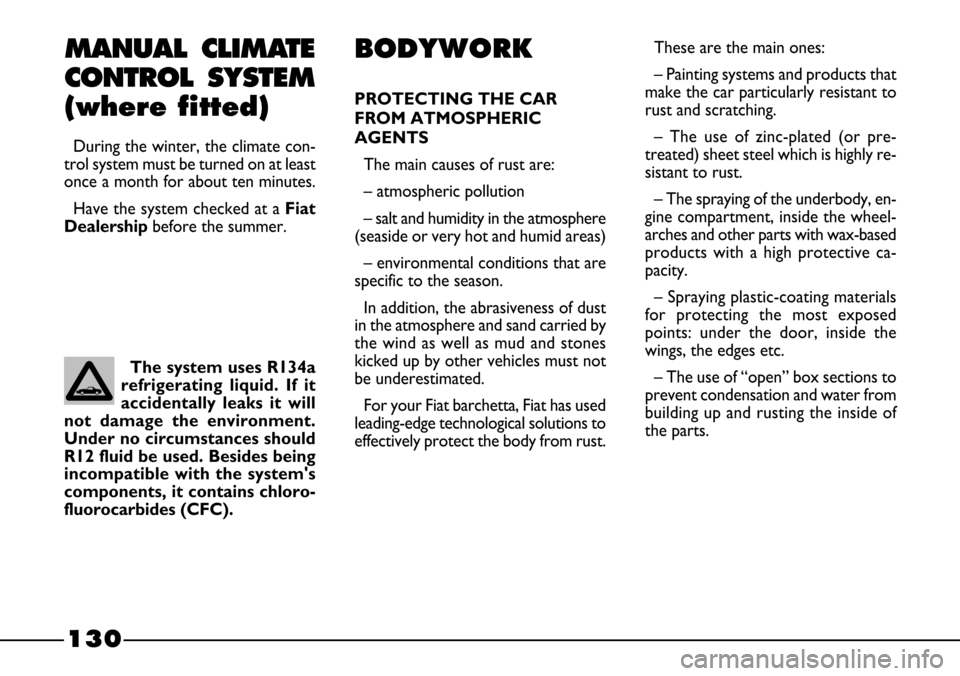
130
BODYWORK
PROTECTING THE CAR
FROM ATMOSPHERIC
AGENTS
The main causes of rust are:
– atmospheric pollution
– salt and humidity in the atmosphere
(seaside or very hot and humid areas)
– environmental conditions that are
specific to the season.
In addition, the abrasiveness of dust
in the atmosphere and sand carried by
the wind as well as mud and stones
kicked up by other vehicles must not
be underestimated.
For your Fiat barchetta, Fiat has used
leading-edge technological solutions to
effectively protect the body from rust.These are the main ones:
– Painting systems and products that
make the car particularly resistant to
rust and scratching.
– The use of zinc-plated (or pre-
treated) sheet steel which is highly re-
sistant to rust.
– The spraying of the underbody, en-
gine compartment, inside the wheel-
arches and other parts with wax-based
products with a high protective ca-
pacity.
– Spraying plastic-coating materials
for protecting the most exposed
points: under the door, inside the
wings, the edges etc.
– The use of “open” box sections to
prevent condensation and water from
building up and rusting the inside of
the parts.
MANUAL CLIMATE
CONTROL SYSTEM
(where fitted)
During the winter, the climate con-
trol system must be turned on at least
once a month for about ten minutes.
Have the system checked at a Fiat
Dealershipbefore the summer.
The system uses R134a
refrigerating liquid. If it
accidentally leaks it will
not damage the environment.
Under no circumstances should
R12 fluid be used. Besides being
incompatible with the system's
components, it contains chloro-
fluorocarbides (CFC).
Page 132 of 170
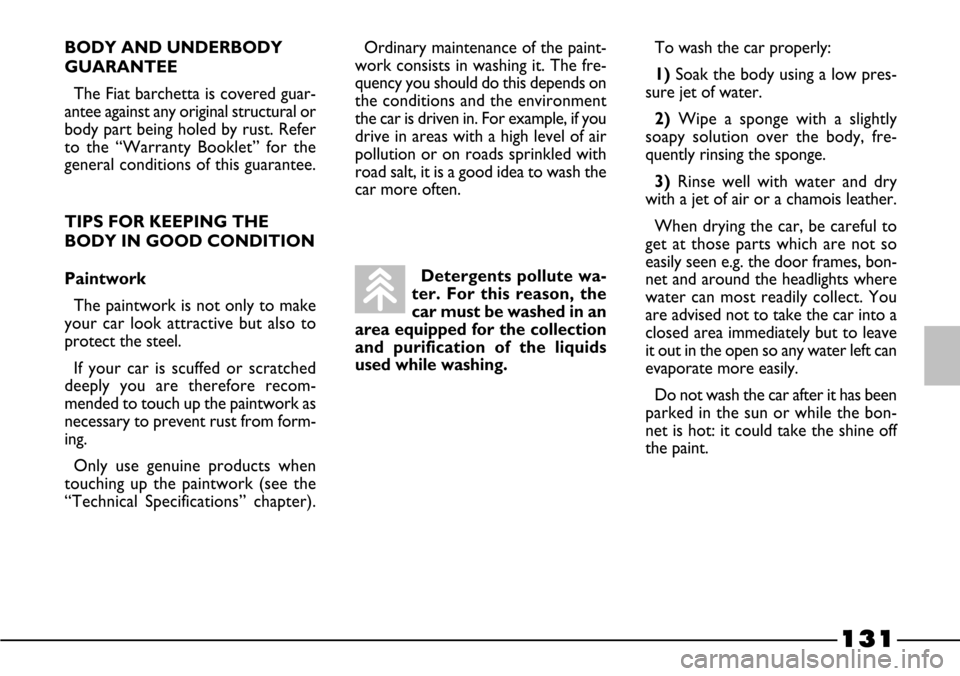
131
BODY AND UNDERBODY
GUARANTEE
The Fiat barchetta is covered guar-
antee against any original structural or
body part being holed by rust. Refer
to the “Warranty Booklet” for the
general conditions of this guarantee.
TIPS FOR KEEPING THE
BODY IN GOOD CONDITION
Paintwork
The paintwork is not only to make
your car look attractive but also to
protect the steel.
If your car is scuffed or scratched
deeply you are therefore recom-
mended to touch up the paintwork as
necessary to prevent rust from form-
ing.
Only use genuine products when
touching up the paintwork (see the
“Technical Specifications” chapter).To wash the car properly:
1) Soak the body using a low pres-
sure jet of water.
2) Wipe a sponge with a slightly
soapy solution over the body, fre-
quently rinsing the sponge.
3)Rinse well with water and dry
with a jet of air or a chamois leather.
When drying the car, be careful to
get at those parts which are not so
easily seen e.g. the door frames, bon-
net and around the headlights where
water can most readily collect. You
are advised not to take the car into a
closed area immediately but to leave
it out in the open so any water left can
evaporate more easily.
Do not wash the car after it has been
parked in the sun or while the bon-
net is hot: it could take the shine off
the paint. Ordinary maintenance of the paint-
work consists in washing it. The fre-
quency you should do this depends on
the conditions and the environment
the car is driven in. For example, if you
drive in areas with a high level of air
pollution or on roads sprinkled with
road salt, it is a good idea to wash the
car more often.
Detergents pollute wa-
ter. For this reason, the
car must be washed in an
area equipped for the collection
and purification of the liquids
used while washing.
Page 133 of 170
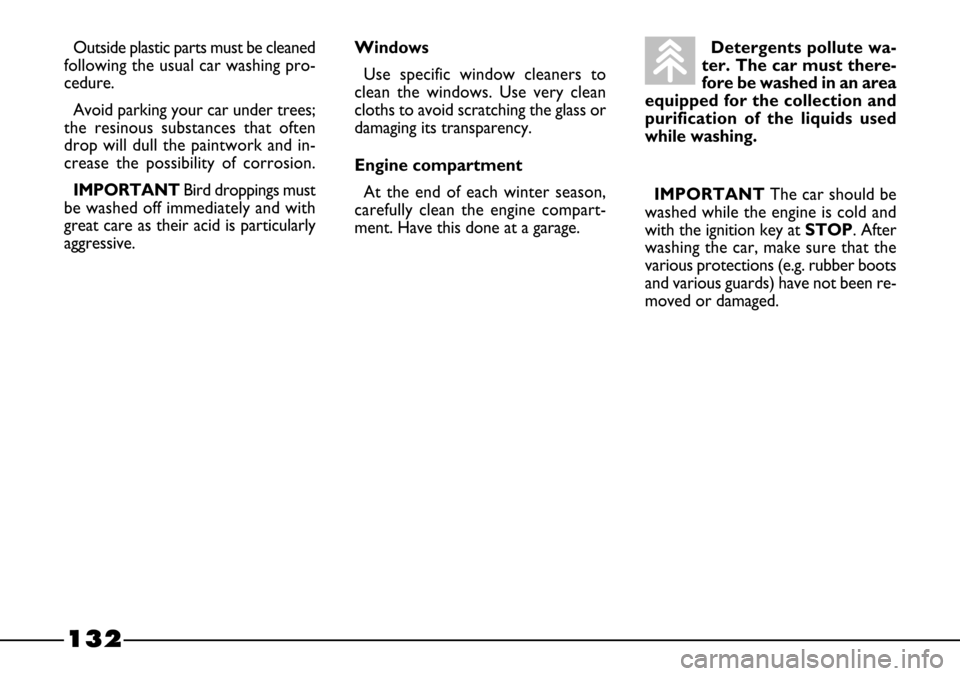
132
Windows
Use specific window cleaners to
clean the windows. Use very clean
cloths to avoid scratching the glass or
damaging its transparency.
Engine compartment
At the end of each winter season,
carefully clean the engine compart-
ment. Have this done at a garage.Detergents pollute wa-
ter. The car must there-
fore be washed in an area
equipped for the collection and
purification of the liquids used
while washing.
IMPORTANTThe car should be
washed while the engine is cold and
with the ignition key at STOP. After
washing the car, make sure that the
various protections (e.g. rubber boots
and various guards) have not been re-
moved or damaged. Outside plastic parts must be cleaned
following the usual car washing pro-
cedure.
Avoid parking your car under trees;
the resinous substances that often
drop will dull the paintwork and in-
crease the possibility of corrosion.
IMPORTANT Bird droppings must
be washed off immediately and with
great care as their acid is particularly
aggressive.
Page 134 of 170
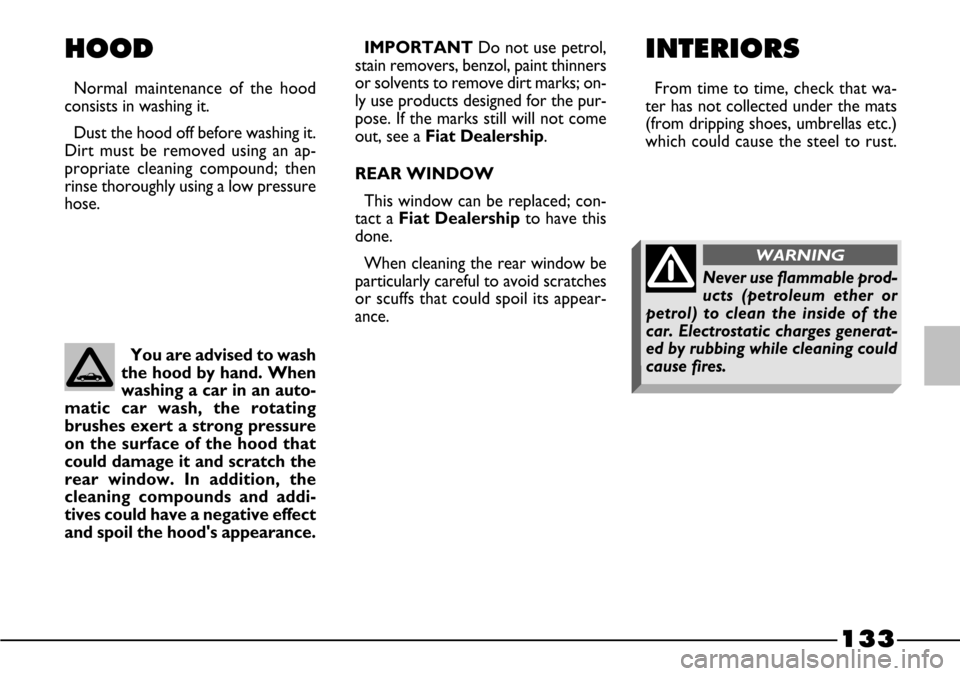
133
HOOD
Normal maintenance of the hood
consists in washing it.
Dust the hood off before washing it.
Dirt must be removed using an ap-
propriate cleaning compound; then
rinse thoroughly using a low pressure
hose.
INTERIORS
From time to time, check that wa-
ter has not collected under the mats
(from dripping shoes, umbrellas etc.)
which could cause the steel to rust.
You are advised to wash
the hood by hand. When
washing a car in an auto-
matic car wash, the rotating
brushes exert a strong pressure
on the surface of the hood that
could damage it and scratch the
rear window. In addition, the
cleaning compounds and addi-
tives could have a negative effect
and spoil the hood's appearance.IMPORTANT Do not use petrol,
stain removers, benzol, paint thinners
or solvents to remove dirt marks; on-
ly use products designed for the pur-
pose. If the marks still will not come
out, see a Fiat Dealership.
REAR WINDOW
This window can be replaced; con-
tact a Fiat Dealershipto have this
done.
When cleaning the rear window be
particularly careful to avoid scratches
or scuffs that could spoil its appear-
ance.
Never use flammable prod-
ucts (petroleum ether or
petrol) to clean the inside of the
car. Electrostatic charges generat-
ed by rubbing while cleaning could
cause fires.
WARNING
Page 135 of 170
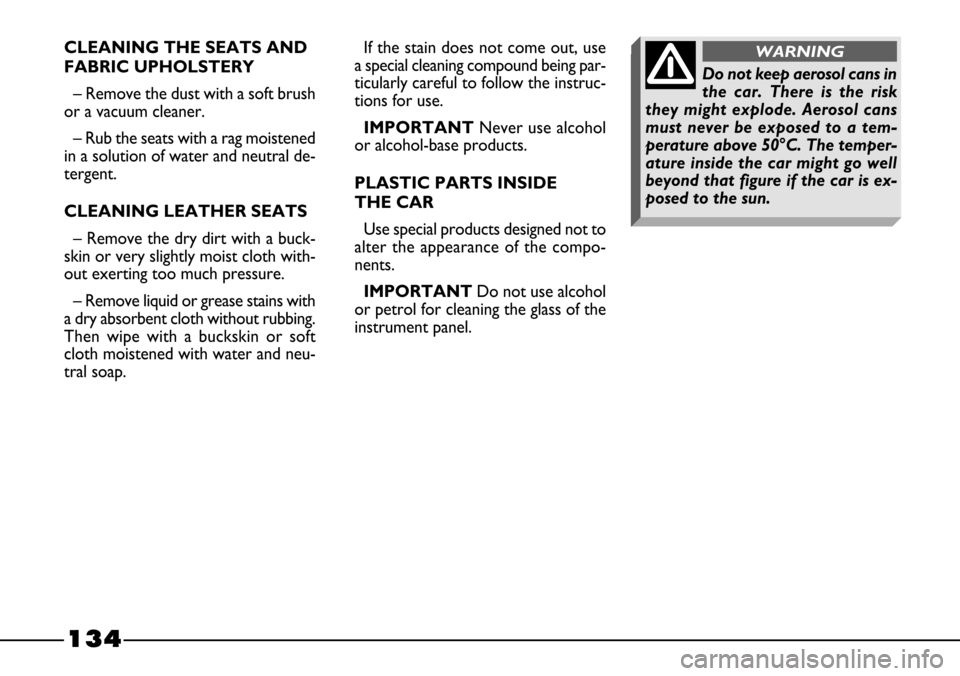
134
If the stain does not come out, use
a special cleaning compound being par-
ticularly careful to follow the instruc-
tions for use.
IMPORTANTNever use alcohol
or alcohol-base products.
PLASTIC PARTS INSIDE
THE CAR
Use special products designed not to
alter the appearance of the compo-
nents.
IMPORTANT Do not use alcohol
or petrol for cleaning the glass of the
instrument panel. CLEANING THE SEATS AND
FABRIC UPHOLSTERY
– Remove the dust with a soft brush
or a vacuum cleaner.
– Rub the seats with a rag moistened
in a solution of water and neutral de-
tergent.
CLEANING LEATHER SEATS
– Remove the dry dirt with a buck-
skin or very slightly moist cloth with-
out exerting too much pressure.
– Remove liquid or grease stains with
a dry absorbent cloth without rubbing.
Then wipe with a buckskin or soft
cloth moistened with water and neu-
tral soap.
Do not keep aerosol cans in
the car. There is the risk
they might explode. Aerosol cans
must never be exposed to a tem-
perature above 50°C. The temper-
ature inside the car might go well
beyond that figure if the car is ex-
posed to the sun.
WARNING
Page 136 of 170
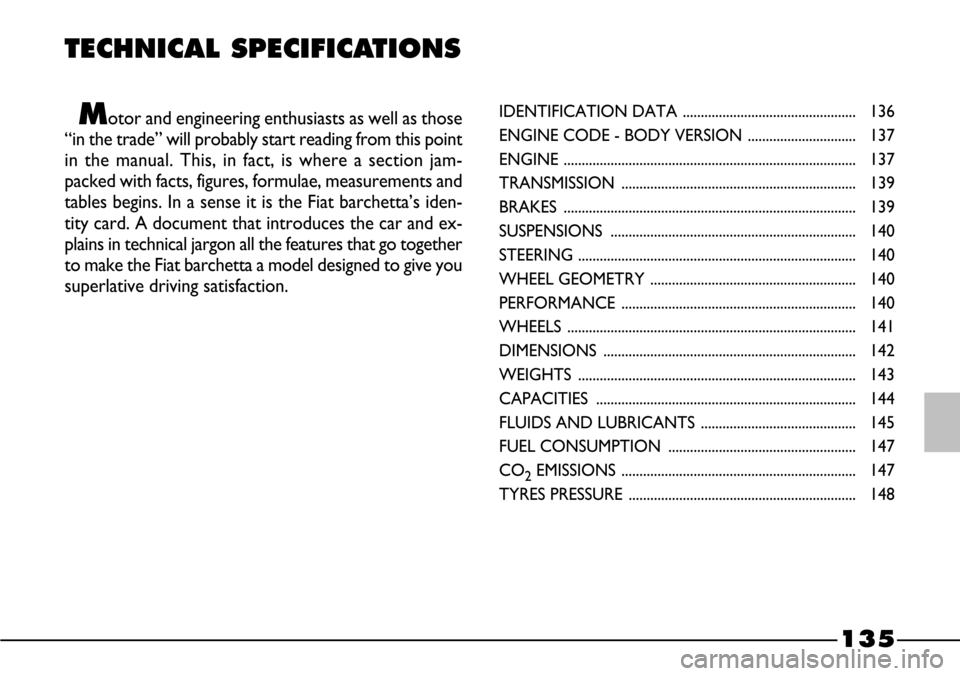
135
TECHNICAL SPECIFICATIONS
Motor and engineering enthusiasts as well as those
“in the trade” will probably start reading from this point
in the manual. This, in fact, is where a section jam-
packed with facts, figures, formulae, measurements and
tables begins. In a sense it is the Fiat barchetta’s iden-
tity card. A document that introduces the car and ex-
plains in technical jargon all the features that go together
to make the Fiat barchetta a model designed to give you
superlative driving satisfaction.IDENTIFICATION DATA ................................................ 136
ENGINE CODE - BODY VERSION .............................. 137
ENGINE ................................................................................. 137
TRANSMISSION ................................................................. 139
BRAKES ................................................................................. 139
SUSPENSIONS .................................................................... 140
STEERING ............................................................................. 140
WHEEL GEOMETRY ......................................................... 140
PERFORMANCE ................................................................. 140
WHEELS ................................................................................ 141
DIMENSIONS ...................................................................... 142
WEIGHTS ............................................................................. 143
CAPACITIES ........................................................................ 144
FLUIDS AND LUBRICANTS ........................................... 145
FUEL CONSUMPTION .................................................... 147
CO
2EMISSIONS ................................................................. 147
TYRES PRESSURE ............................................................... 148
Page 137 of 170
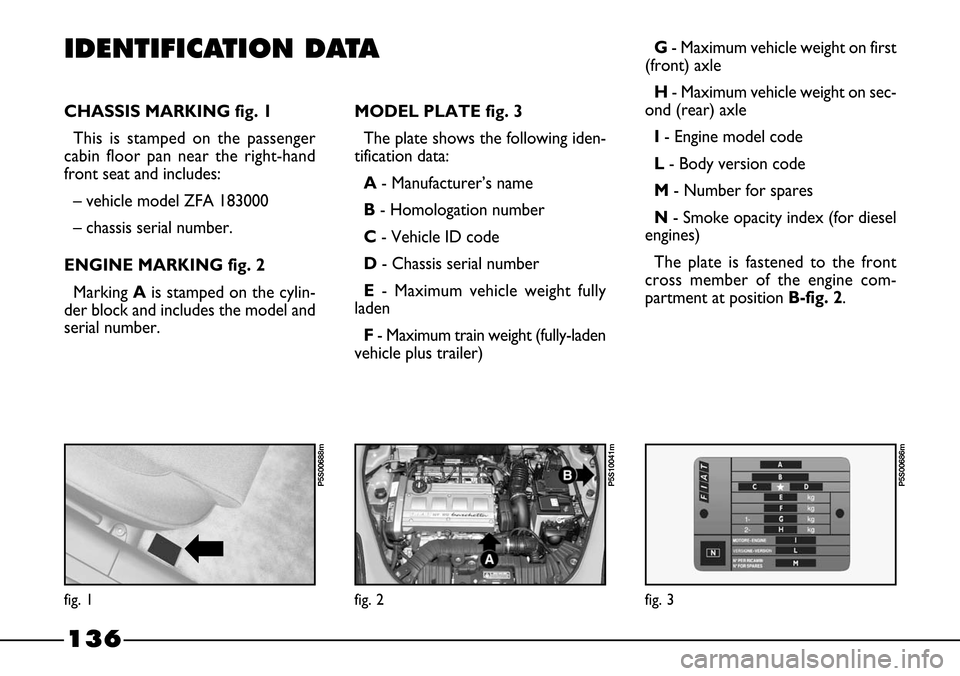
136
IDENTIFICATION DATA
MODEL PLATE fig. 3
The plate shows the following iden-
tification data:
A- Manufacturer’s name
B- Homologation number
C- Vehicle ID code
D- Chassis serial number
E- Maximum vehicle weight fully
laden
F- Maximum train weight (fully-laden
vehicle plus trailer)
fig. 2
P5S10041m
fig. 3
P5S00686m
fig. 1
P5S00688m
G- Maximum vehicle weight on first
(front) axle
H- Maximum vehicle weight on sec-
ond (rear) axle
I - Engine model code
L- Body version code
M- Number for spares
N- Smoke opacity index (for diesel
engines)
The plate is fastened to the front
cross member of the engine com-
partment at position B-fig. 2. CHASSIS MARKING fig. 1
This is stamped on the passenger
cabin floor pan near the right-hand
front seat and includes:
– vehicle model ZFA 183000
– chassis serial number.
ENGINE MARKING fig. 2
Marking Ais stamped on the cylin-
der block and includes the model and
serial number.
Page 138 of 170
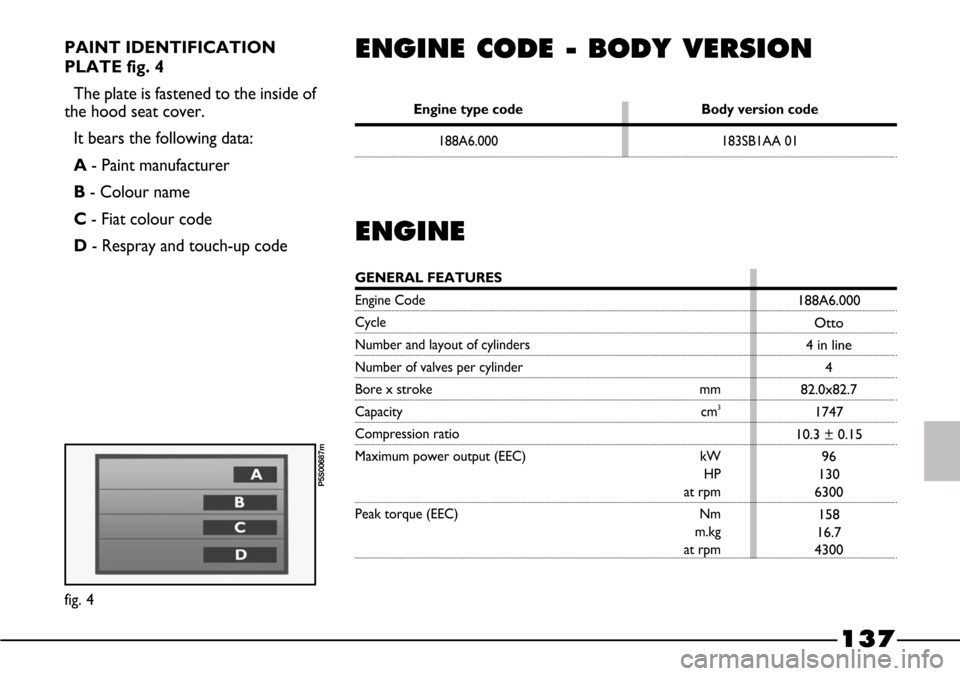
ENGINE CODE - BODY VERSION
137
Engine type code Body version code
188A6.000 183SB1AA 01
PAINT IDENTIFICATION
PLATE fig. 4
The plate is fastened to the inside of
the hood seat cover.
It bears the following data:
A- Paint manufacturer
B- Colour name
C- Fiat colour code
D- Respray and touch-up code
fig. 4
P5S00687m
ENGINE
GENERAL FEATURES
Engine Code
Cycle
Number and layout of cylinders
Number of valves per cylinder
Bore x stroke mm
Capacity cm3
Compression ratio
Maximum power output (EEC) kW
HP
at rpm
Peak torque (EEC) Nm
m.kg
at rpm
188A6.000
Otto
4 in line
4
82.0x82.7
1747
10.3 ± 0.15
96
130
6300
158
16.7
4300
Page 139 of 170
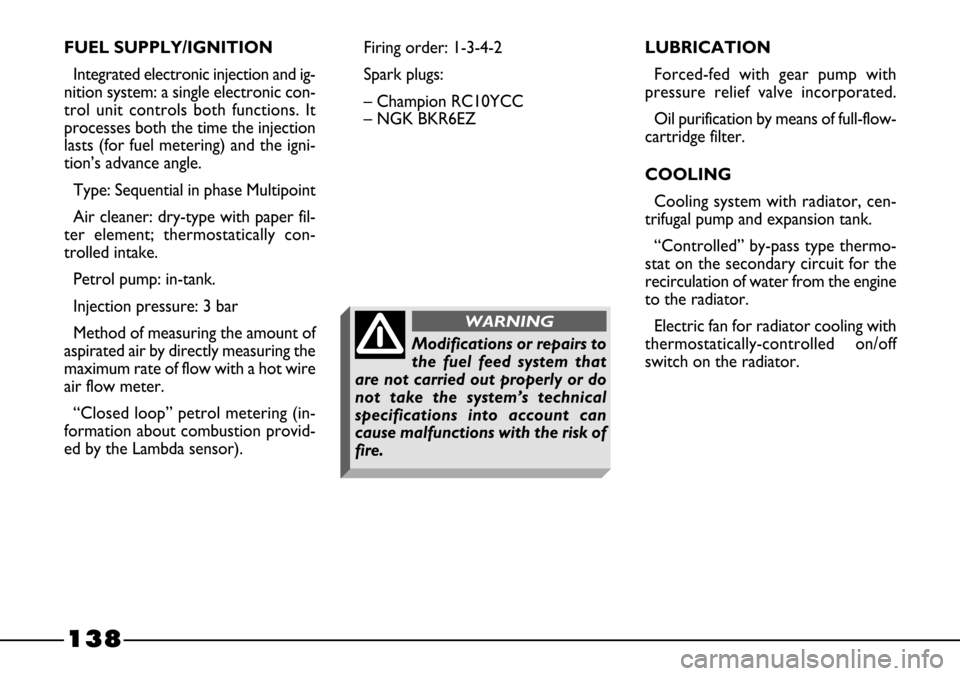
138
FUEL SUPPLY/IGNITION
Integrated electronic injection and ig-
nition system: a single electronic con-
trol unit controls both functions. It
processes both the time the injection
lasts (for fuel metering) and the igni-
tion’s advance angle.
Type: Sequential in phase Multipoint
Air cleaner: dry-type with paper fil-
ter element; thermostatically con-
trolled intake.
Petrol pump: in-tank.
Injection pressure: 3 bar
Method of measuring the amount of
aspirated air by directly measuring the
maximum rate of flow with a hot wire
air flow meter.
“Closed loop” petrol metering (in-
formation about combustion provid-
ed by the Lambda sensor).Firing order: 1-3-4-2
Spark plugs:
– Champion RC10YCC
– NGK BKR6EZLUBRICATION
Forced-fed with gear pump with
pressure relief valve incorporated.
Oil purification by means of full-flow-
cartridge filter.
COOLING
Cooling system with radiator, cen-
trifugal pump and expansion tank.
“Controlled” by-pass type thermo-
stat on the secondary circuit for the
recirculation of water from the engine
to the radiator.
Electric fan for radiator cooling with
thermostatically-controlled on/off
switch on the radiator.
Modifications or repairs to
the fuel feed system that
are not carried out properly or do
not take the system’s technical
specifications into account can
cause malfunctions with the risk of
fire.
WARNING
Page 140 of 170
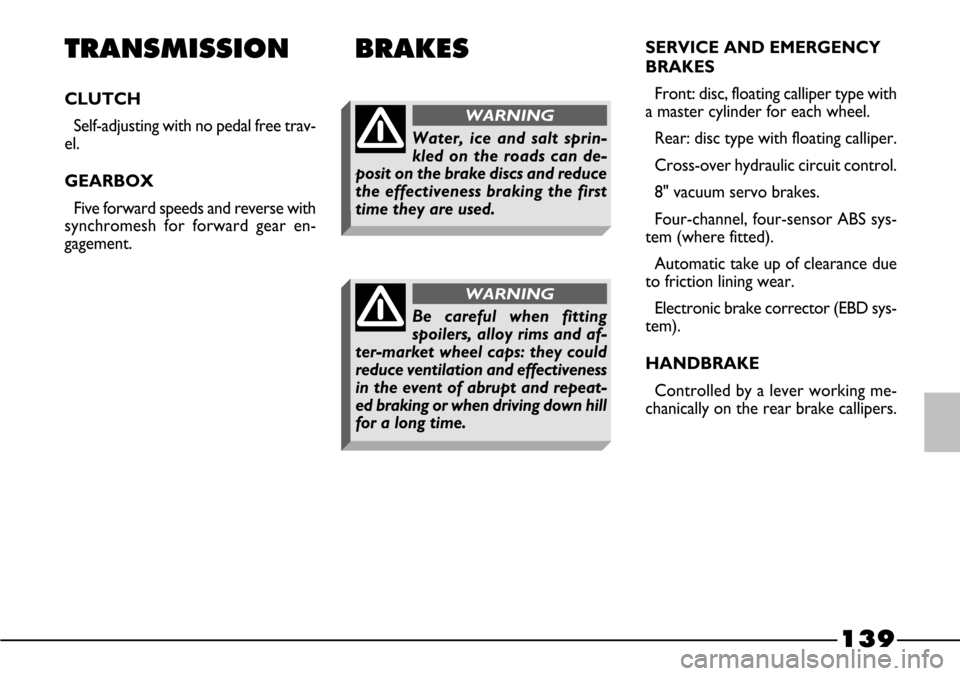
139
TRANSMISSION
CLUTCH
Self-adjusting with no pedal free trav-
el.
GEARBOX
Five forward speeds and reverse with
synchromesh for forward gear en-
gagement. SERVICE AND EMERGENCY
BRAKES
Front: disc, floating calliper type with
a master cylinder for each wheel.
Rear: disc type with floating calliper.
Cross-over hydraulic circuit control.
8" vacuum servo brakes.
Four-channel, four-sensor ABS sys-
tem (where fitted).
Automatic take up of clearance due
to friction lining wear.
Electronic brake corrector (EBD sys-
tem).
HANDBRAKE
Controlled by a lever working me-
chanically on the rear brake callipers.
BRAKES
Water, ice and salt sprin-
kled on the roads can de-
posit on the brake discs and reduce
the effectiveness braking the first
time they are used.
WARNING
Be careful when fitting
spoilers, alloy rims and af-
ter-market wheel caps: they could
reduce ventilation and effectiveness
in the event of abrupt and repeat-
ed braking or when driving down hill
for a long time.
WARNING